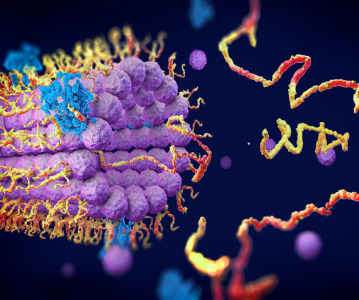NIH study uncovers clues about why common cancer drug causes hearing loss

Researchers find target to protect hearing during chemotherapy treatment.
Scientists have found a new way to explain the hearing loss caused by cisplatin, a powerful drug used to treat many forms of cancer. Using a highly sensitive technique to measure and map cisplatin in mouse and human inner ear tissues, researchers found that forms of cisplatin build up in the inner ear. They also found a region in the inner ear that could be targeted for efforts to prevent hearing loss from cisplatin.
Cisplatin and similar platinum-based drugs are prescribed for an estimated 10-20% of all cancer patients. The NIH’s National Cancer Institute supported research that led to the 1965 discovery of cisplatin and continued development leading to its success as an essential weapon in the battle against cancer. The drugs cause permanent hearing loss in 40-80% of adult patients and at least half of children who receive the drug. The new findings help explain why cisplatin is so toxic to the inner ear, and why hearing loss gets worse after each treatment, can occur long after treatment, and is more severe in children than adults.
In most areas of the body, cisplatin is eliminated within days or weeks after treatment, but in the inner ear, the drug remains much longer. Previous research focused on why the inner ear is more sensitive than other parts of the body to cisplatin-induced damage. The NIH team pursued a new angle on the problem: What if the inner ear is not able to get rid of cisplatin, and cells in the inner ear important for hearing die because they are exposed to the drug for a long time?
The team developed a mouse model that represents cisplatin-induced hearing loss seen in human patients. By looking at inner ear tissue of mice after the first, second, and third cisplatin treatment, researchers saw that cisplatin remained in the mouse inner ear much longer than in most other body tissues, and that it builds up with each successive treatment. They also studied inner ear tissue donated by deceased adult patients who had been treated with cisplatin, and observed that cisplatin is retained in the inner ear many months or years after treatment. In addition, when they examined inner ear tissue from one child, they found cisplatin buildup that was even higher than seen in adults. These results suggest that the inner ear readily takes up cisplatin, but it has very little ability to remove the drug.
In mice and human tissues, the research team saw the highest buildup of cisplatin in a part of the inner ear called the stria vascularis, which helps maintain the positive electrical charge in inner ear fluid that certain cells need to detect sound. The research team determined that the accumulation of cisplatin in the stria vascularis portion of the inner ear contributed to cisplatin-related hearing loss.
“Our findings suggest that if we can prevent cisplatin from entering the stria vascularis in the inner ear during treatment, we may be able to protect cancer patients from developing cisplatin-induced hearing loss,” said Cunningham.
The study, published in Nature Communications), was supported by the National Institute on Deafness and other Communications Disorders (NIDCD), part of the National Institutes of Health.
Lisa L. Cunningham, chief of the NIDCD Section on Sensory Cell Biology, led the research team, which included scientists from the National Institute on Minority Health and Health Disparities (NIMHD) and the National Center for Advancing Translational Sciences (NCATS). Support for data analysis was provided by Electro Scientific Industries of Bozeman, Montana.
Related News
-
News CPHI Podcast Series: The power of proteins in antibody drug development
In the latest episode of the CPHI Podcast Series, Lucy Chard is joined by Thomas Cornell from Abzena to discuss protein engineering for drug design and development. -
News Amgen sues Samsung biologics unit over biosimilar for bone disease
Samsung Bioepis, the biologics unit of Samsung, has been issued a lawsuit brought forth by Amgen over proposed biosimilars of Amgen’s bone drugs Prolia and Xgeva. -
News CPHI Podcast Series: Why we need to consider women in clinical trials
The latest episode of the CPHI Podcast Series with Lucy Chard covers women's health, specifically women's representation in clinical trials, the associated bias, and the impacts on health for this population. -
News US FDA does not approve MDMA therapy for PTSD, requests more data
The MDMA-based therapeutic developed by Lykos Therapeutics, a California-based Public Benefit Corporation (PBC), has been reviewed and unapproved by the US FDA. The regulator has requested additional phase III trial data for further safety and efficacy... -
News Novartis and Viatris latest facing lawsuit over HeLa cell misuse
Global pharmaceutical companies Novartis and Viatris are the latest hit with a lawsuit claim pertaining to alleged misuse of the ‘HeLa’ cell line from the estate of woman whose cancerous tissue cells were taken without consent. -
News Sanofi invests billions into Frankfurt insulin production site
French pharmaceutical company Sanofi have announced an investment of EUR1.3 billion at their existing BioCampus site in Frankfurt am Main for the expansion of insulin production. -
News Novel oral Type 1 diabetes drug gains US FDA IND designation
A University of Alabama at Birmingham startup has gained FDA clearance for Investigational New Drug clinical trials for an oral Type 1 diabetes drug, a milestone for diabetes treatment. -
News A Day in the Life of a Vice President in R&D & Engineering
In the Day in the Life of Series, we've already had the chance to get to know a range of people in various roles in the pharma industry. In the latest interview we get a glimpse into the R&D side of things from Jennifer Sorrells, Vice Presiden...
Position your company at the heart of the global Pharma industry with a CPHI Online membership
-
Your products and solutions visible to thousands of visitors within the largest Pharma marketplace
-
Generate high-quality, engaged leads for your business, all year round
-
Promote your business as the industry’s thought-leader by hosting your reports, brochures and videos within your profile
-
Your company’s profile boosted at all participating CPHI events
-
An easy-to-use platform with a detailed dashboard showing your leads and performance

.png)

.png)
.png)
.png)
.png)
